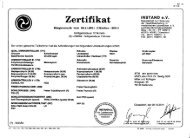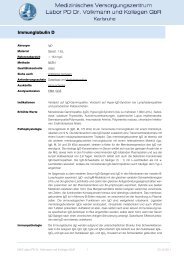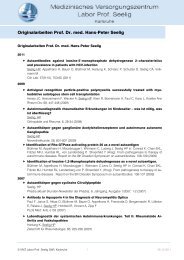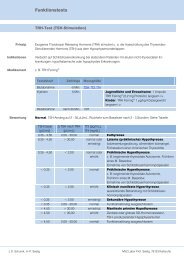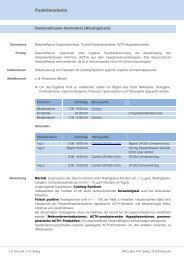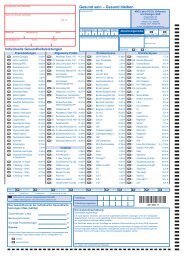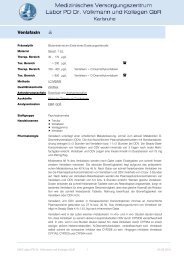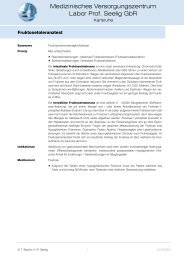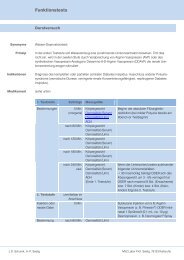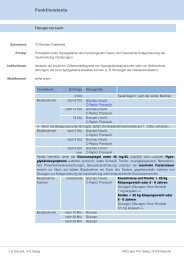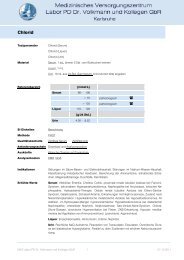Seelig HP - Autoantikörper
Seelig HP - Autoantikörper
Seelig HP - Autoantikörper
Sie wollen auch ein ePaper? Erhöhen Sie die Reichweite Ihrer Titel.
YUMPU macht aus Druck-PDFs automatisch weboptimierte ePaper, die Google liebt.
806 H.-P. <strong>Seelig</strong>: Autoantikörper<br />
körper gegen dieses Antigen nachweisen, die<br />
Krankheit kann durch aktive und passive Immunisierung<br />
im Tiermodell induziert werden.<br />
Mit α 3-Untereinheiten immunisierte<br />
Kaninchen entwickeln eine der menschlichen<br />
Krankheit vergleichbare autonome Gangliopathie,<br />
deren Schwere mit der Höhe der Antikörperspiegel<br />
korreliert (24). Bei Mäusen<br />
entwickelt sich nach passivem Transfer antikörperhaltiger<br />
Kaninchen- oder Humanseren<br />
eine reversible Gangliopathie (52), deren<br />
Symptome nach drei bis fünf Tagen ein Maximum<br />
erreichen. Die zeitverzögerte Entwicklung<br />
der autonomen Symptome kann dahingehend<br />
gedeutet werden, dass der synaptische<br />
Transmissionsdefekt durch eine Modulierung<br />
der Rezeptoren ausgelöst wird. Hierbei<br />
kommt es zu einer antikörpervermittelten<br />
Quervernetzung der Rezeptoren, dadurch zur<br />
Endozytose und zur vermehrten Rezeptordegradation.<br />
Die Antikörper hemmen dosisabhängig<br />
die Signalübertragung ganglionärer<br />
nAChR in IMR-32-Zellen bzw. stabil mit humanen<br />
α 3β 2-, α 3β 4-, α 3α 5β 4-Untereinheiten<br />
transfizierten HEK-Zellen. Der durch Azetylcholin<br />
induzierbare Anstieg des intrazellulären<br />
Kalziums ist vermindert oder aufgehoben<br />
(37, 46, 55, 60, 64).<br />
Auch die beim Menschen erhobenen Befunde<br />
sprechen dafür, dass die autonomen<br />
Dysfunktionen durch Autoantikörper verursacht<br />
werden. Die Autoantikörperkonzentration<br />
im Blut korreliert mit dem Schweregrad<br />
der autonomen Symptome (45, 51) und<br />
ein Abfall der Antikörperkonzentration z. B.<br />
nach Plasmaaustausch oder nach medikamentöser<br />
Therapie geht mit einer deutlichen<br />
Besserung der klinischen Symptome einher<br />
(12, 51). Unklar ist noch, welche Faktoren die<br />
unterschiedliche Ausprägung autonomer<br />
Symptome beeinflussen und ob eine unterschiedliche<br />
Feinspezifität der Autoantikörper<br />
oder zusätzliche Autoantikörper gegen weitere<br />
Untereinheiten der G-nAChR eine Rolle<br />
spielen.<br />
Die Gründe für die Entstehung von Autoantikörpern<br />
gegen G-nAChR bei den idiopathischen<br />
Formen der AAG sind noch unbekannt.<br />
Im Rahmen paraneoplastischer Prozesse<br />
entstehen die Autoantikörper möglicherweise<br />
durch eine Immunantwort auf<br />
aberrant im Tumorgewebe exprimierte Rezeptorproteine.<br />
In Tumorzellen kleinzelliger<br />
Lungenkarzinome wurden z. B. α 7-Untereinheiten<br />
nAChR nachgewiesen (24, 38).<br />
Literatur<br />
1. Arruda WO et al. Autonomic neuropathy in systemic<br />
lupus erythematosus. J Neurol Neurosurg<br />
Psychiatry 1989; 52: 539–540.<br />
2. Baker SK, Morillo C, Vernino S. Autoimmune autonomic<br />
gangliopathy with late-onset encephalopathy.<br />
Atonom Neurosci 2009; 146: 29–32.<br />
3. Balestra B et al. Antibodies against neuronal nicotinic<br />
receptor subtypes in neurological disorders. J<br />
Neuroimmunol 2000; 102: 89–97.<br />
4. Bertinotti L et al. The autonomic nervous system in<br />
systemic sclerosis. A review. Clin Rheumatol 2004;<br />
23: 1–5.<br />
5. Briani C et al. Antibodies to muscle and ganglionic<br />
acetylcholine receptors (AchR) in celiac disease.<br />
Autoimmunity 2008; 41: 100–104.<br />
6. Camdessanche JP et al. Paraneoplastic peripheral<br />
neuropathy associated with anti-Hu antibodies. A<br />
clinical and electrophysiological study of 20 patients.<br />
Brain 2002; 125: 166–175.<br />
7. Dalmau J et al. Anti-Hu-associated paraneoplastic<br />
encephalomyelitis/sensory neuronopathy. A clinical<br />
study of 71 patients. Medicine 1992; 71: 59–72.<br />
8. Dhamija R et al. Serologic profiles aiding the diagnosis<br />
of autoimmune gastrointestinal dysmotility.<br />
Clin Gastroenterol Hepatol 2008; 6: 989–992.<br />
9. Fitch RW et al. Membrane potential fluorescence: a<br />
rapid and highly sensitive assay for nicotinic receptor<br />
channel function. Proc Natl Acad Sci USA 2003;<br />
100: 4909–4914.<br />
10. Gibbons CH et al. L-DOPS therapy for refractory<br />
orthostatic hypotension in autoimmune autonomic<br />
neuropathy. Neurology 2005; 65: 1104–1108.<br />
11. Gibbons CH, Vernino SA, Freeman R. Combined<br />
immunomodulatory therapy in autoimmune autonomic<br />
gangliopathy. Arch Neurol 2008; 65:<br />
213–217.<br />
12. Gibbons CH, Freeman R. Antibody titers predict<br />
clinical features of autoimmune gangliopathy. Autonom<br />
Neurosci 2009; 146: 8–12.<br />
13. Goldstein DS et al. Pandysautonomia associated<br />
with impaired ganglionic neurotransmission and<br />
circulating antibody to the neuronal nicotinic receptor.<br />
Clin Auton Res 2002; 12: 281–285.<br />
14. Goldstein DS, Holmes C, Imrich R. Clinical laboratory<br />
evaluation of autonomic gangliopathy. Autonom<br />
Neurosci 2009; 146: 18–21.<br />
15. Goto H et al. Chronic autonomic neuropathy in a<br />
patient with primary Sjogren's syndrome. J Neurol<br />
Neurosurg Psychiatry 2000; 69: 135.<br />
16. Graus F et al. Anti-Hu-associated paraneoplastic<br />
encephalomyelitis: analysis of 200 patients. Brain<br />
2001; 124: 1138–1148.<br />
17. Hoyle C, Ewing DJ, Parker AC. Acute autonomic<br />
neuropathy in association with systemic lupus<br />
erythematosus. Ann Rheum Dis 1985; 44: 420–424.<br />
18. Iodice V et al. Immunotherapy for autoimmune autonomic<br />
gangliopathy. Autonom Neurosci 2009;<br />
146: 22–25.<br />
19. Klein CM et al. The spectrum of autoimmune autonomic<br />
neuropathies. Ann Neurol 2003; 53:<br />
752–758.<br />
20. Klein CM. Evaluation and management of autonomy<br />
neurons system disorders. Sem Neurol 2008;<br />
28: 195–204.<br />
21. Kondo T et al. Autoimmune autonomic gangliopathy<br />
with Sjögren’s syndrome: Significance of gan-<br />
glionic acetylcholine receptor antibody and therapeutic<br />
approach. Autonom Neurosci 2009; 146:<br />
33–35.<br />
22. Kovács L et al. Cardiovascular autonomic dysfunction<br />
in primary Sjögren's syndrome. Rheumatology<br />
2004; 43: 95–99.<br />
23. Lennon VA et al. Enteric neuronal autoantibodies in<br />
pseudoobstruction with small-cell lung carcinoma.<br />
Gastroenterology 1991; 100: 137–142.<br />
24. Lennon VA et al. Immunization with neuronal nicotinic<br />
acetylcholine receptor induces neurological<br />
autoimmune disease. J Clin Invest 2003; 111:<br />
907–913.<br />
25. Lindstrom J. Neuronal nicotinic acetylcholine receptors.<br />
Ion Channels 1996; 4: 377–450.<br />
26. Lucchinetti CF, Kimmel DW, Lennon VA. Paraneoplastic<br />
and oncologic profiles of patients seropositive<br />
for type 1 antineuronal nuclear autoantibodies.<br />
Neurology 1998; 50: 652–657.<br />
27. Lukas RJ. Expression of ganglia-type nicotinic<br />
acetylcholine receptors and nicotinic ligand binding<br />
sites by cells of the IMR-32 human neuroblastoma<br />
clonal line. J Pharmacol Exp Ther 1993; 265:<br />
294–302.<br />
28. Lukas RJ et al. International Union of Pharmacology.<br />
XX. Current status of the nomenclature for nicotinic<br />
acetylcholine receptors and their subunits.<br />
Pharmacol Rev 1999; 51: 397–401.<br />
29. Nelson ME, Lindstrom J. Single channel properties<br />
of human alpha3 AChRs: impact of beta2, beta4<br />
and alpha5 subunits. J Physiol 1999; 516: 657–678.<br />
30. Nelson ME et al. Functional properties of human<br />
nicotinic AChRs expressed by IMR-32 neuroblastoma<br />
cells resemble those of alpha3beta4 AChRs expressed<br />
in permanently transfected HEK cells. J Gen<br />
Physiol 2001; 118: 563–582.<br />
31. Pande R, Leis AA. Myasthenia gravis, thymoma, intestinal<br />
pseudo-obstruction, and neuronal nicotinic<br />
acetylchoine receptor antibody. Muscle Nerve<br />
1999; 22: 1600–1602.<br />
32. Pasha SF, Lunsford TN, Lennon VA. Autoimmune<br />
gastrointestinal dysmotility treated successfully<br />
with pyridostigmine. Gastroenterology 2006; 131:<br />
1592–1596.<br />
33. Rakocevic G et al. Myasthenia gravis, thymoma, and<br />
intestinal pseudoobstruction: a case report and review.<br />
J Clin Neuromusc Dis 2003; 5: 93–95.<br />
34. Richardson CE et al. Megacystis-microcolon-intestinal<br />
hypoperistalsis syndrome and the absence of<br />
the alpha3 nicotinic acetylcholine receptor subunit.<br />
Gastroenterology 2001; 121: 350–357.<br />
35. Rose NR, Bona C. Defining criteria for autoimmune<br />
diseases (Witebsky’s postulates revisited).<br />
Immunology Today 1993; 14: 426–430.<br />
36. Sandroni P, Low PA. Other autonomic neuropathies<br />
associated with ganglionic antibody. Autonom<br />
Neurosci 2009; 146: 13–17.<br />
37. Schroeder C et al. Plasma Exchange for primary<br />
autoimmune autonomic failure. N Engl J Med<br />
2005; 353: 1585–1590.<br />
38. Sciamanna MA et al. Nicotinic acetylcholine receptors<br />
of muscle and neuronal (alpha7) types coexpressed<br />
in a small cell lung carcinoma. J Neurochem<br />
1997; 69: 2302–2311.<br />
39. Skok MV et al. Alpha subunit composition of nicotinic<br />
acetylcholine receptors in the rat autonomic<br />
ganglia neurons as determined with subunit-specific<br />
anti-alpha. Neuroscience 1999; 93: 1427–1436.<br />
Nervenheilkunde 11/2009 © Schattauer 2009



